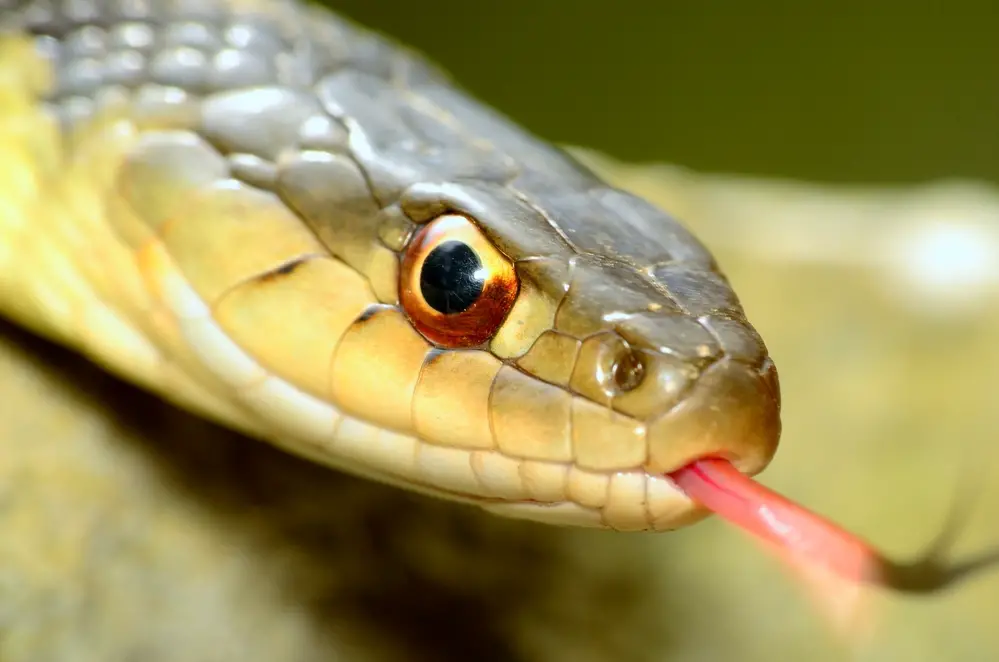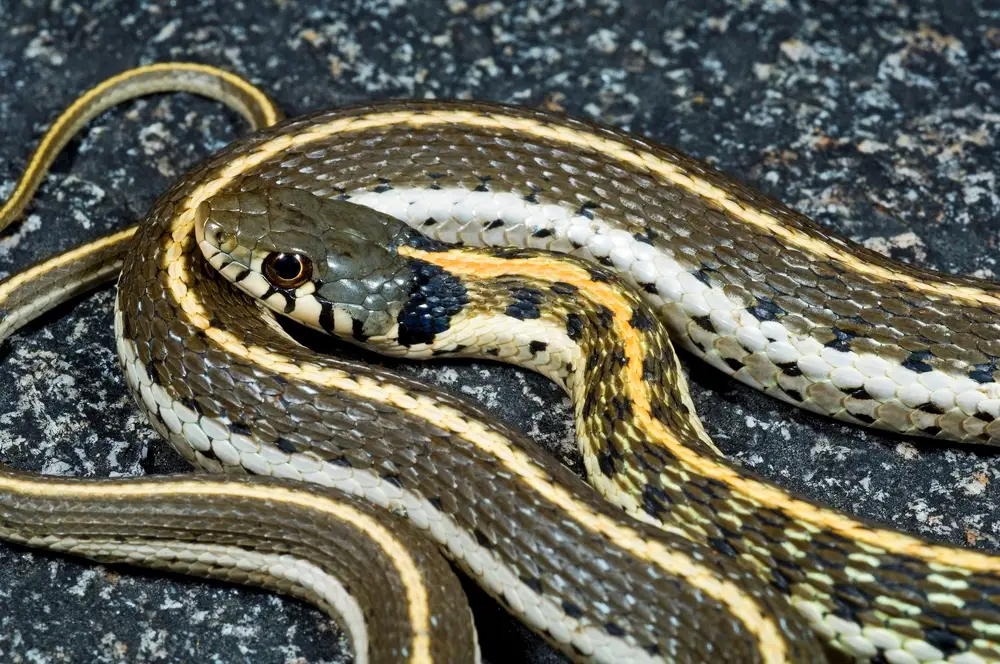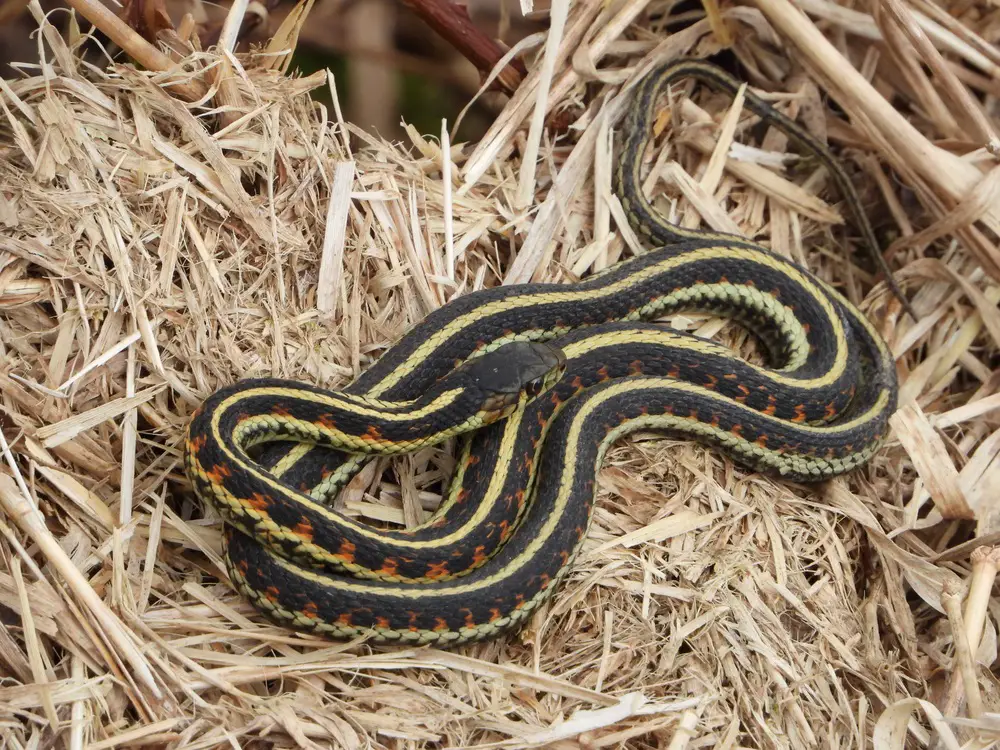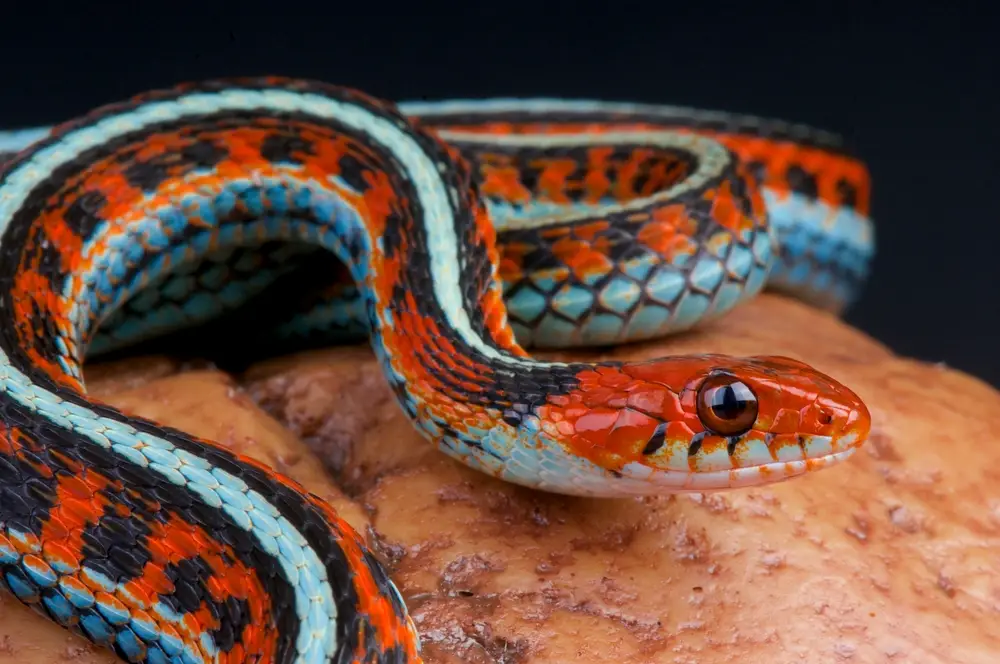Most Garter Snakes get to around 2-3ft in length, but some do get much larger. Let’s take a look at the average lengths of well-known Garter Snake species…
Garter snakes are among the most widespread species in North America, known for their distinctive stripes and habit of being active during the day. They play an important role in ecosystems by helping to control pests. When adult, they range from 2 to 5 feet in length, depending on the species in question.

How big do garter snakes get in feet?
On average, adult garter snakes typically grow between 24 and 36 inches in length (2-3 feet). However, some individuals can reach up to 42 inches in length, and ones species even reaches 60 inches+.
Check out the table below to see the average sizes of some of the more well-known Garter Snake species and subspecies:
| Species | Average Length inches/feet |
|---|---|
| Eastern Garter Snake/Common Garter Snake (Thamnophis sirtalis) | 18-26inches/1.5-2feet |
| Blue Striped Garter Snake (Thamnophis sirtalis similis) | 18-26inches/1.5-2feet |
| Western Terrestrial Garter Snake (Thamnophis elegans) | 24-42inches/2-3.5feet |
| Northwestern Garter Snake (Thamnophis ordinoides) | 18-36inches/1.5-3feet |
| San Francisco Garter Snake (Thamnophis sirtalis tetrataenia) | 24-36inches/2-3feet |
| Checkered Garter Snake (Thamnophis marcianus) | 20-28inches/1.6-2.3feet |
| Plains Garter Snake (Thamnophis radix) | 16-28inches/1.3-2.3feet |
| Giant Garter Snake (Thamnophis gigas) | 36-60inches/3-5feet |
| Red-Sided Garter Snake (Thamnophis sirtalis parietalis) | 22-36inches/1.8-3feet |
| Aquatic Garter Snake (Thamnophis atratus) | 24-36inches/2-3feet |
| Butler’s Garter Snake (Thamnophis butleri) | 18-24inches/1.5-2feet |
| Western Blackneck Garter Snake (Thamnophis cyrtopsis cyrtopsis) | 24-36inches/2-3feet |
| Eastern Blackneck Garter Snake (Thamnophis cyrtopsis ocellatus) | 16-24inches/1.3-2feet |

Can a garter snake hurt you?
Garter snakes are usually not harmful to humans and are not known to bite or cause injury unlees you grab or step on them. However, they can produce a foul-smelling secretion as a defense mechanism.
Some individuals may be carriers of Salmonella bacteria, so it’s best to handle them cautiously and wash your hands thoroughly after handling them.
Over the years, there’s been a few studies done on Garter Snake saliva and bites. One publication observed a bad reaction in a little girl from an Eastern Garter Snake bite.
Another one detailed a case of blisters occurring after a Wandering Garter Snake bite. That time, a 16 year old snake enthusiast let the snake bite him – then pressed its teeth into his finger for a whole five minutes while he walked home (thanks buddy, you’ve really helped our hobby’s reputation. As if people didn’t already think we were weird!).
In both cases, symptoms only occurred after prolonged bites. It seems that Garter Snakes are technically venomous because they produce toxic saliva. However, it is so weak that I really don’t consider them to be truly ‘venomous’ in the same way that a Rattlesnake is.
In a nutshell, if a Garter Snake bites you for a second, you’ll almost certainly have zero symptoms. If you let it chew on your finger for 5-10 minutes you’ll get some swelling, itching and perhaps redness, though. But then again, why would anyone do that?

10 Interesting facts about garter snakes
Here are ten interesting facts about garter snakes:
- Garter snakes are the most common species of snake found in North America.
- Their name comes from the stripes on their body, which resemble garters traditionally worn to hold up socks.
- They are very mildly ‘venomous’ and feed on small animals like fish, frogs, and rodents.
- Garter snakes are highly adaptable and can live in various habitats, including forests, fields, and suburban areas.
- They are mostly active during the day and are known for their excellent swimming ability.
- They are social creatures and can often be found in large groups, especially during mating season.
- Garter snakes use their sense of smell to locate their prey and to detect potential threats.
- Garter snakes are viviparous, meaning they give live birth to young that are fully formed and ready to hunt.
- They play an important role in controlling the populations of their prey and are also an important food source for predators like birds of prey and raccoons.
- The dual-colored tongue of most Garter snakes is another distinguishing feature. It’s red with a black tip.
How big is the biggest garter snake?
The maximum length of a garter snake is typically around 4–5 feet. Some larger individuals may reach lengths of up to 5 feet, but this is relatively rare. The size of a garter snake depends on several factors, including the species, the environment, and food availability.
The largest species of Garter Snake overall is the Giant Garter Snake (Thamnophis gigas) from central California. This species is semi-aquatic and is both longer and heavier than other species. There are several records of them reaching 65inches/5.5feet in length.
How to find a garter snake den?
Finding a garter snake den can be done by following these steps:
- Observe their behavior: Garter snakes are most active in the spring and early summer, during which they may be seen basking in the sun or moving through the grass. Observing their movements can give clues about where they might be living.
- Look for key habitats: Garter snakes are often found near water sources such as streams, ponds, and lakes. They also commonly live in dense vegetation, such as thick grass or bushes.
- Check for dens in good hiding places: Garter snakes are known to den in various locations, including rocky crevices, hollow logs, burrows, and old buildings. You can look for signs of snake activity around these types of structures, such as shed skins or droppings.
- Ask a local expert: If you are having difficulty finding a garter snake den, you can contact local wildlife experts or herpetologists. They can provide more information about the local snake population and where they are known to the den.
Remember that garter snakes are protected in many areas, so it’s important to observe them from a safe distance and never disturb their dens.

Should you remove garter snakes from your yard?
Garter snakes are not dangerous and play an important role in controlling pests. So removing them may upset the balance of the ecosystem in your yard.
However, if someone in your household has a phobia, you may wish to remove them. Do it humanely if you decide to remove garter snakes from your yard. Relocating them to a nearby natural area is the best option.
If you’re not sure what to do, contact your local animal welfare charity, rather than an exterminator.
How often do garter snakes eat?
Garter snakes are opportunistic feeders. They can eat anywhere from once a week to several times a week, depending on their size, age, and food availability.
Young garter snakes tend to eat more frequently than adults. During the summer, they may feed multiple times a week when food is abundant. In the winter, garter snakes may slow down their feeding and go into brumation.
Sometimes, how often they eat depends on what prey they get. I used to keep an Eastern Garter Snake (Common Garter Snake) as a kid and would feed her a large frog or toad every 7 to 10 days. This was a fairly large meal, though.
If a Garter Snake finds smaller prey like worms or other invertebrates then it might eat almost every day during periods of activity.
What attracts garter snakes to your house?
Garter snakes are attracted to houses for several reasons, including:
- Food: Garter snakes may be attracted if there is an abundance of prey, such as insects, small rodents, or frogs, near a house.
- Shelter: Garter snakes may also seek shelter in and around houses, especially in areas that provide warmth and protection from predators.
- Water: Garter snakes may be drawn if a house has a water source, such as a pond or pool, to drink from and hunt for aquatic prey.
- Environment: A house and its surroundings can provide a suitable environment for garter snakes to thrive. Especially if there is an abundance of vegetation, rocks, or logs to provide cover. The more varied the environment the better for them.

What does a garter snake eat?
Garter snakes are omnivores and feed on a variety of prey, including small rodents, fish, amphibians, insects, and earthworms. In addition, garter snakes may consume small birds and their eggs, slugs, snails, and leeches.
Garter snakes’ diet can vary depending on the species and food availability in their environment. They are opportunistic feeders and can eat whatever prey is readily available to them.
Notwithstanding, over most of their range they seem to have a strong preference for invertebrates and amphibians. A lot of them get very excited if you give them nightcrawlers, for example.

Does one snake mean more?
A single garter snake in an area does not necessarily indicate a larger population of snakes because they do occasionally wander quite far in search of mates or food.
The number of snakes in a particular area can depend on various factors, including food availability, habitat quality, and seasonal changes.
One snake’s presence may indicate that it has successfully found food and shelter in that area. It is also possible that the snake is an individual wanderer and is not part of a larger population.
Do garter snakes lay eggs?
Garter Snakes do not lay eggs. They give birth to live young are tiny replicas of the adulthoods. Often, the females seek a nice, humid area to give birth, such as a compost pile or shaded area away from direct sun.
In my experience, Garters generally have at least 10 babies, and 20 or 30 is reasonably common.

FAQ relating to how big garter snakes get?
What are garter snakes afraid of?
Like many other species of snakes, Garter snakes have instinctive responses to perceived threats, such as fear and defensive behaviors. Some common things that garter snakes may be afraid of include:
- Loud noises and sudden movements (they can hear a little, contrary to popular belief)
- Large predators – or their shadows
- Unfamiliar objects or environments
By keeping them in a safe and secure habitat and avoiding sudden movements or loud noises, you can help reduce their fear and promote their well-being. As pets, this means putting their enclosure in area of your house with low traffic (see my article on where to put your snake enclosure for more info’ on this).
Can a garter snake hurt a dog?
Garter snakes are usually not dangerous to dogs and are not capable of causing severe harm. While garter snakes have venom, it’s incredibly weak and not typically dangerous to dogs.
In most cases, a bite from a garter snake will only cause the tiniest of scratches and is unlikely to pose a severe threat to a healthy dog.
It is also important to note that garter snakes are usually shy and will avoid confrontation whenever possible. They will only bite in self-defense if they feel threatened.
Are garter snakes active at night?
Garter snakes are primarily diurnal, meaning they are most active during the day. However, they may be active at night in certain circumstances, such as when the temperature is higher or when they are searching for food.
During heat waves, even strictly diurnal snakes may temporarily become nocturnal because they just can’t function well during the heat of the day.
Key Takeaways
- Garter snakes are small, harmless, and commonly found in North America.
- They can grow up to 2–3 feet, with some reaching up to 4–5 feet.
- They feed on small animals like fish, frogs, and rodents and are mostly active during the day.
- Some species live in a variety of habitats, but most stay near water sources and dense vegetation.
- Garter snakes play an important role in controlling pest populations and are an important food source for predators.
- They are live-bearing and usually have at least ten babies
- They are attracted to our backyards for food, shelter, water, and a suitable environment.
- Garter snakes feed opportunistically, from once a week to several times a week, depending on size, age, and food availability.
